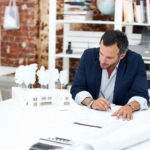How to Draw Your Own Plans

The world of design and construction can seem impossible to jump into when you are first starting. Picture this: you recently bought a house and decide that the beautiful, spacious backyard can fit a small guest house perfectly. To save money, you decide to forgo hiring an architect and instead draw your own plans yourself to gain city approval and finally begin construction. The only problem is you have never designed anything before, let alone an entire guest house.
At Permit Advisors, many of our employees are licensed architects. We deal with plans all day long. If we’re not going over them with the city, we’re talking with the architects who designed them one-on-one to point out any safety concerns. With our in-depth knowledge of building plans, we wanted to create a brief guide on how to draw your own plans for any project that you might have coming up.
To begin, it’s important to remember that cities require you to show a plan that goes into detail the scope of your project. Since city approval is mandatory before starting your project, you need to make sure your drawing is as close to perfect as possible. The better it is when you present it to the city, the sooner you’ll be on your way to your start date.
Tools You Need to Bring
- Paper (preferably grid)
- Pencil (B, H, and HB lead)
- Good Eraser
- Ruler, with Architectural and Engineering Scales
- Calculator
- Table and Comfortable Chair
Now that your workstation and tools are ready, you can start drawing your plan. Begin noting on your piece of paper what is the direction North and a small compass that points to the other directions. Then, add your property’s address and distinguish what is the name of the closest street sign. Next to this write down what the scale being used is. For example, “Scale: ¼:1” which means ¼ inch for every 1 square foot, or whatever measuring system you choose to use. You should then write your name and the date next to these two items. These two things are incredibly important for the city to see as it will help them review your plan and determine if it is up to code enough to be approved for construction.
After that, you will begin sketching carefully the details of your planned building (including width and depth). Be sure to maintain your chosen scale throughout this process. You should be noting the height via a label. If there is any relevant information about construction you need to disclose, write it on the side for the city to be aware of. This could be a “steel fence, five feet high” or “pool built next to shed”.

Your sketch should start with the perimeter if you are drawing a floor plan for a new building. Label each room, as well as doors, windows, counters, bathroom fixtures, kitchen appliances, and closets, as well as their sizes. Markdown the locations of the smoke and carbon dioxide detectors. Following that, you will need to sketch additional pages depending on the prerequisites particular to your project. If you are sketching a new building or addition, you will have to provide a foundation plan with an overhead view that shows slabs, footings, and the strength of the concrete to be used. For an addition on a residential property, you will have to create a section drawing to show a side view that allows the city planner to see how the addition will be constructed. In this case, you will have to show the location of new wall studs, rafters, insulation, and roofing.
Don’t forget to add an elevation drawing for any permit that entails a change to the exterior of your home. Also be sure to show any new windows, chimneys, and other changes.
Finally, provide a table of contents in the calculation package. Here you will identify the pages of each topic: such as seismic mass, bass shear, shear transfer, drag strut, and foundation design.
Please remember that each jurisdiction demand requirements that are specific to their municipality. Do your research before drawing your plans to make sure you have a guideline for every item you need to include.
EXAMPLE: New Orleans Plan Requirements
- Plot plan reflecting all dimensions of the lot and all structures, setbacks to property lines and the location and dimensions of off-street parking spaces
- Complete Digital Plans, stamped with live seals from a Louisiana licensed Architect or Civil Engineer
- Foundation drawings detailing the foundation of the proposed structure with live, original seals, stamped by a Louisiana registered architect or civil engineer
- Proposed use of structure
- Number of floors or levels in the structure
Permit Advisors has multiple architects and ex-city planners on staff that has been reviewing plans for years. We know what the city looks out for and we can find the solutions to any problems that may occur. If you have any questions, please reach out to us at (310) 275-7774 and a Project Manager will be more than happy to speak with you.
Sources: http://www.totalconstructionhelp.com/plans.html https://www.hunker.com/13400817/how-to-draw-plans-for-building-permits https://www.nola.gov/onestop/building/construction/new-construction-(building)-permit/




